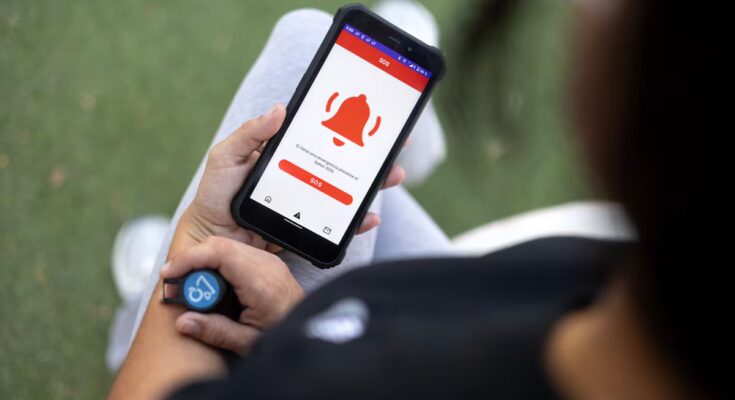Last Tuesday, the Ministry of Equality, together with the state security forces, activated the protection protocol for victims using the anti-abuse bracelet system due to a failure of the devices twelve hours after learning of the failure. The Ministry confirmed that the system suffered a general failure and that it managed to regain normality after a few hours. Furthermore, the women’s emergency service – the panic button – works normally, Igualdad says, and none of them activated it during this breakdown. The victims were informed, “being protected at all times”, he says.
This system manages electronic control bracelets that allow you to know the exact location of sexist attackers with restraining orders, so that they serve to protect women – who also carry devices – and document possible violations.
According to sources close to the Cometa company, the system would have suffered the accident around 4 in the morning, which would have prevented access to the application with which they work in the system, which is why the Police and Civil Guard were notified to activate the protection protocols. The same sources say that the workers say they do not have enough information: “They were only told that the system was not working, without saying anything else or giving any kind of instructions on what to say to the victims, the police or the attackers.” The ministry does not confirm this information.
Equality assures that the minister, Ana Redondo, and the Government delegate against gender violence, Carmen Martínez-Perza, have been in contact with the Vodafone-Securitas UTE responsible for the service, “also appearing in the Cometa Room, to learn firsthand about the evolution of the incident”. After evaluating all the technical options, it was ascertained that the origin of the problem lies in a router that distributes messages to different platforms depending on the type of alert, explains the Ministry. Approximately 10% of these messages generate recurring incidents that cause an overload of the system which, however, is already in the process of returning to normal.
“We will investigate to the end and, if necessary, we will take appropriate action,” said the head of Equality. The Ministry specifies that Redondo “is in solidarity” with the victims and that the protection system “goes beyond telematic devices and includes an institutional protection network with a multitude of professionals who guarantee their safety even in the event of a technological accident”.
Redondo said in a message on the social network “Although the system may fail, the protocols do not. We are working to return to normality,” he recalled. “I want to send a message of tranquility. No victim has ever been without protection. The protocols worked. The forces and security bodies guaranteed the safety of the victims, who were immediately informed.”
Ana Redondo: “I want to send a message of calm. No victim has ever been without protection. The protocols worked. The Forces and Security Bodies guaranteed the safety of the victims, who were informed immediately.” pic.twitter.com/BuV69jC1Ta
— Ministry of Equality (@IgualdadGob) November 11, 2025
In Spain, currently, more than 4,500 men wear these bracelets. An accident during their operation has put the spotlight on these devices, which have been used in the country since 2009. There is no evidence that a woman has been killed while wearing one of these anti-abuse devices. Since 2009, a total of 21,036 women have used them at least once.
These bracelets are activated by court order: a bracelet is installed on the wrist or ankle of the offender who has a restraining order, because he has been convicted or because he is awaiting sentencing. Tampering with the device results in a fine. Violation of the restrictive order, governed by article 468 of the penal code, can lead to imprisonment from six months to three years if the protected person is a victim of gender violence.
The victim is given a smartphone that issues a warning if the man approaches, violating the no-approach ban. The installation of this system aims to ensure the safety of the woman, to document any violations of the restraining order and to dissuade the attacker from violating the prohibitions imposed by the judiciary.
The geolocation bracelet has a strap that detects breakages and manipulations, has a useful life of 12 months and is easily recharged. The victim can receive notifications on their phone, make video calls, send images and send alert messages to the control center.
The bracelets were initially installed to protect victims of gender violence, but, according to the “only yes means yes” law, they can also be used to monitor the location of sex offenders. They no longer work only in pairs (one attacker, one victim), but the bracelet of a suspect or convicted person can be synchronized with the terminal of multiple victims, and the same victim can be protected from multiple attackers.
87% of victims feel safer with the telematic device, 88% of victims, despite recognizing its defects, believe that the system is “very effective” or “fairly effective”, and that 90% would recommend the measure to women in a similar situation, according to data from Sala Cometa.
A month ago it was reported that these same bracelets had suffered a failure because in 2023, when the awarding of the service changed companies – from Telefónica, which subcontracted with Securitas Direct, to the UTE (temporary joint venture) between Vodafone and Securitas -, in that transition there was a problem in the data dump from one supplier to another which meant that for a few months the movements of these men could not be known before March 20 2024, which, the state Attorney General explained, meant a “potential lack of protection for victims,” as noted in its latest annual report.
The operators of the Control Center for Telematic Removal Measures (Comet) explained a month ago to El País that there were faults in the GPS of the devices: sudden changes in the location of the attacker, “geographical inaccuracies” that did not coincide with the restrictive orders issued by the courts or the “freezing” of the position of the bracelets due to “forced restarts”, prohibited according to the documents. There have also been cases in which the attacker took off or turned off the bracelet without the Cometa center receiving notification.
The 016 telephone line assists victims of sexist violence, their families and those around them 24 hours a day, every day of the year, in 53 different languages. The number is not recorded on the phone bill, but the call must be canceled from the device. You can also contact via email 016-online@igualdad.gob.es and via WhatsApp on 600 000 016. Minors can contact the ANAR Foundation telephone number 900 20 20 10. In case of emergency it is possible to call 112 or the telephone numbers of the State Police (091) and the Civil Guard (062). And if you can’t call you can use the ALERTCOPS application, from which an alert signal is sent to the Police with geolocation.



